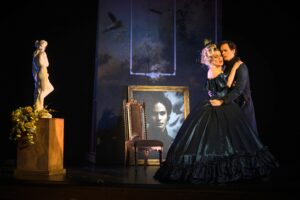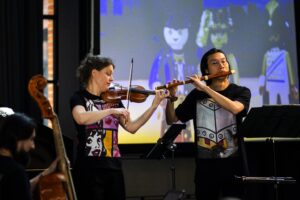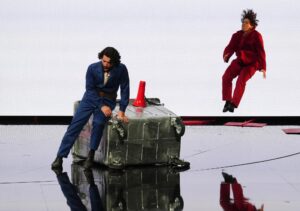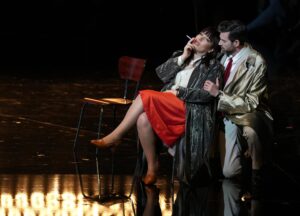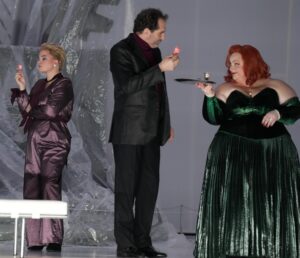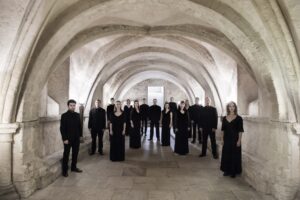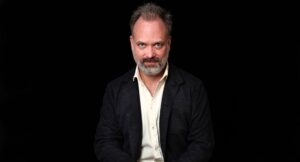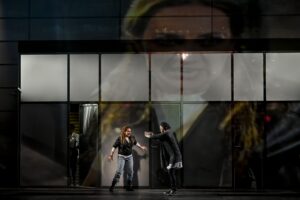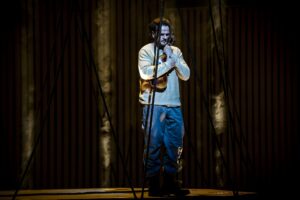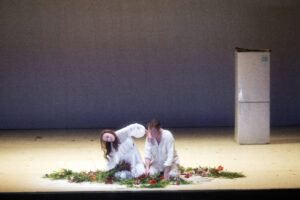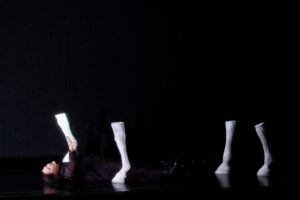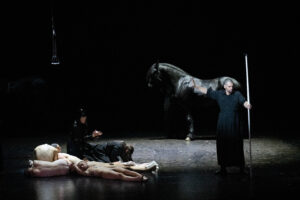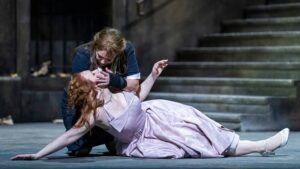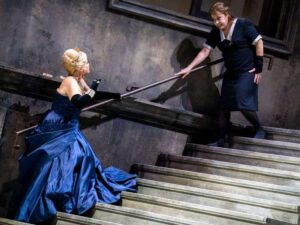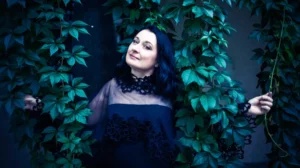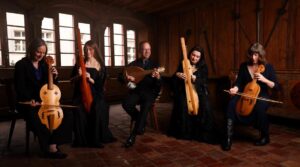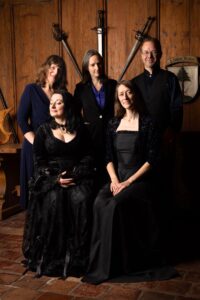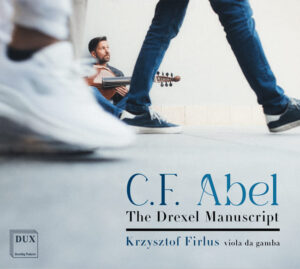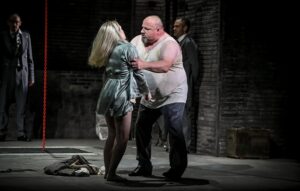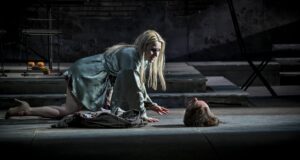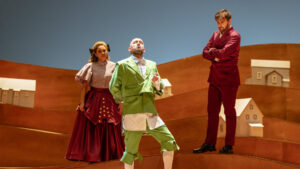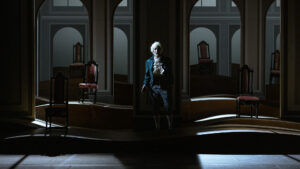The Dark Tenderness of the Sarabande
Agatha Christie once said that the books we read would return to us in an extraordinary manner. Sometimes music does too. Last year I arrived in Göttingen straight from Venice, after a performance of Il trionfo del Tempo e del Disinganno at Teatro Malibran – and I did not expect that arias from this oratorio would come back to me not only at the Handel Festival, but also several months later at Bayreuth Baroque. This season I planned to arrive for the finale of the Göttingen festival, but I had to change my plans and came for the first three days of the event – which was launched by a performance of Il trionfo by the soloists and the FestspielOrchester conducted by George Petrou. “Lascia la spina” returned to me again the following day. And not just once. In a manner as extraordinary as it was unexpected.
This year’s inauguration took place in the newly restored Stadthalle on the outskirts of the Old Town. Until recently, the future of the huge building, erected in the early 1960s on the basis of Rainer Schell’s design, hung in the balance. The building was in a poor technical condition. Some residents still have not got used to its modernist aesthetics: primarily its unusual facade made of iridescent ceramic slabs, to which the Stadthalle owes its derisive nickname “tiled stove”. Doubts were raised as to whether the structural elements made of asbestos and exposed during the renovation might not pose a health risk to the public. The renovation works were prolonged due to the pandemic and in the end cost more than double the planned amount. Critics did not go silent even after the grand opening of the Stadthalle in January 2024. Specialists complained about, for example, the concert hall’s acoustic defects, which, despite costly treatments, could not be eliminated in a space restored in accordance with the original architectural design.
There is no denying it, it is no Musikverein, and lovers of nineteenth-century symphonic music certainly have a right to feel disappointed. However, Handel’s oratorio, featuring a small orchestra and four soloists, sounded sufficiently selective and transparent in the Stadthalle for listeners to be able to fully appreciate the pulse, emotion and drama of this youthful masterpiece. The production was discreetly directed by Ilka Seifert, Sasha Waltz’s assistant for the Warsaw production of Hosokawa’s Matsukaze, supported by other collaborators of the German choreographer: Folkert Uhde, author of symbolic, non-distracting video projections, and Jörg Bittner, responsible for the lighting. However, their efforts would have been of no use, if it had not been for the thoughtful interpretation of Petrou, who opted for a highly difficult – and masterfully implemented by the musicians – idea of gradually, almost imperceptibly slowing down the narrative until finally “stopping the time”. The FestspielOrchester Göttingen, founded in 2006 by Nicholas McGegan, who added instrumentalists with long-standing ties to the festival to its line-up, is on a par with Europe’s best baroque ensembles. Petrou knows not only how to make it sound as a unified organism, but also how to give showcase the individual virtuosos (led by the phenomenal oboist Susanne Regel; Fernando Aguado, an organist with an exceptional sense of style; and the concertmistress, about whom more in a moment). He also works brilliantly with singers, who created a convincing quartet of “living” allegories – despite an unexpected cast change in the role of Bellezza.
Il Trionfo del Tempo e del Disinganno. Anna Dennis (Bellezza) and Elizabeth Blumenstock (violin). Photo: Alciro Theodoro da Silva
Or maybe it was because of this change, as the indisposed Louise Kemény was replaced by the phenomenal singer actress Anna Dennis, an artist with an expressive soprano, whose colour she can shade, as if she were mixing pigments on a palette. I was very impressed by Emöke Barath as Piacere. Hers is a rich, dark soprano with superb support, which she demonstrated in the aria “Lascia la spina”, sung in an exceptionally slow, “languid” tempo. Xavier Sabata did a surprisingly fine job as Disinganno, making up for some shortcomings of his now fading countertenor with a wise interpretation. The young Emanuel Tomljenović, an artist endowed with a full, handsome and perfectly placed tenor, effortlessly overcame all the difficulties of the role of Tempo, although in his case I did miss a deeper reflection on the text.
Regardless of the musical qualities of the performance, the audience was certainly impressed by the director’s beautiful yet simple decision to have Bellezza take the first violinist Elizabeth Blumenstock by the hand in the finale, bring her out of the orchestra, seat her in a chair at the front of the stage and sing “Tu del Ciel ministro eletto” in such an intimate duet with the concertmistress that the audience became oblivious to the whole world. Who knows, perhaps what moved me more than the singing was the stylish playing of the veteran of the historically informed performance practice moving the bow across the strings of an instrument that was already “grown up” when Handel was born.
The day after the dazzling inauguration we moved to the Deutsches Theater, where a new staging of one of the festival patron’s operas is premiered each year. This time the organisers surprised some regulars by joining the growing campaign to resurrect the pasticcio genre. I have written about it many times, especially in the context of Rivoluzione e Nostalgia at La Monnaie, so I don’t need to convince anybody how fervently I am supporting it. Nor do I need to say that it takes a great deal of knowledge, and not just musicological knowledge, to create a good pasticcio; that it takes painstaking work and angelic patience; and, above all, that it requires a true belief in the durability and power of the operatic form.
Krystian Lada demonstrated that it was possible to assemble a coherent story about the 1968 revolt and its far-reaching consequences from fragments of Verdi’s operas. George Petrou and Laurence Dale – a fine British tenor who took up directing and conducting after a triumphant career – opted for a seemingly more conservative approach, creating a Handelian pasticcio on the basis of Balzac’s short story “Sarrasine”. Few people remember, however, that the second life of this 1830 literary miniature began precisely in 1968, with a seminar devoted to it by Roland Barthes, who published the transcript of his lectures at the École pratique des hautes études in Paris in his famous book S/Z. In it he carried out a brilliant deconstruction of the “logic of the plot”, the axis of which is the story of a young, rebellious sculptor and his obsessive love for the beautiful singer Zambinella – unwilling to make a closer acquaintance with the artist, who has no idea that the object of his yearning is, in fact, a beautiful castrato.
The weakness of Barthes’ new theory of meanings was pointed out by, among others, Ewa Bieńkowska, who wrote that when reading S/Z she got the impression she was dealing with a man for whom “reading is a delight and who would like to share this subtle pleasure with us”. However, the book caused quite a stir across the world and attracted a wave of interest in Balzac’s forgotten piece, for obvious reasons also among musicians and theatre people. The story of Sarrasine and Zambinella was told by, for example, Neil Bartlett in a once famous operatic vaudeville with music by Nicolas Bloomfield.
Sarrasine. Myrsini Margariti (Madame de Rochefide) and Sreten Manojlović (Balzac). Photo: Alciro Theodoro da Silva
Petrou and Dale approached Sarrasine the way Bieńkowska once imagined Barthes engrossed in Balzac, “savouring every word, summoning to his aid … all his learning, all the knowledge and associations provided by a solid and wide-ranging education”. Petrou compiled the musical material of the two-act pasticcio exclusively from works by Handel – fragments from operas, cantatas and oratorios (often in alternative versions or those rejected by the composer), as well as excerpts from his concerti grossi – with a recurring sarabande motif, which manifests itself in various forms, from the instrumental fragment from Almira, the aria “Lascia la spina” from Il trionfo, to the sarabande from Suite in D minor HWV 437, so memorably used in Barry Lyndon. Dale added French and Italian dialogues to the libretto.
The artists remained faithful to Balzac’s “story within a story”, highlighting the two parallel love plots – the courtship of the Narrator, identified here with Balzac, of Madame de Rochefide, and Sarrasine’s infatuation with the castrato Zambinella – as well as the clash of opposites present in the literary original: darkness and glamour, youth and old age, beauty and ugliness. This was facilitated by Giorgina Germanou’s sparse sets, well lit by John Bishop, against backdrop of which the set designer was all the more effective in building a multifaceted narrative structure using evocative costumes. She did that in very good collaboration with the director, who directed the soloists – as well three Deutsches Theater actors accompanying them in minor roles – with truly British precision.
The main burden rested with the four singers, the most memorable among whom was Samuel Mariño as Zambinella. It is a role as if made for him: the Venezuelan soprano is distinguished not only by his unusual voice, but also by his intriguing androgynous looks, which, in combination with very decent acting skills, enabled him to create a convincing portrayal of an unhappy castrato. However, I do not share most of my colleagues’ admiration for the vocal side of his performance. Mariño is endowed with a soprano that is undoubtedly lovely, but not backed by solid technique – although he can certainly “cheat” by means of spectacular trills, often unconnected to the logic of phrasing, as well as other, not always stylish embellishments. His volume is slight and he does not even know how to hide this: in fact, he exhausted all his potential in the aria “L’armi implora” from the first act. Musically, he was definitely outshone by Juan Sancho in the title role. I first encountered this singer live last year in Madrid, during the premiere of Corselli’s Achille in Sciro. Some over-expression in his luscious tenor – jarring in the role of Nearco at the time – worked perfectly this time as a vehicle for Sarrasine’s amorous sufferings. The beautiful and subtle Madame de Rochefide was portrayed by the Greek soprano Myrsini Margariti, an artist endowed with a voice that is luminous and wide-open in the upper register, but has too much vibrato at times. The soft, sparkling basso cantante of Sreten Manojlović (Balzac) caught my attention already in 2019, in the Viennese Halka conducted by Łukasz Borowicz, in which Manojlović was given the episodic role of the Piper. At that time I also appreciated his acting talent, although Mariusz Treliński handled the character he portrayed rather unceremoniously. The way Manojlović built the character of Lotario in the production of Flavio at last year’s Bayreuth Baroque became the subject of an in-depth analysis by several of my students at Warsaw’s Academy of Dramatic Arts. His Balzac in Sarrasine demonstrates his consistent development as an artist, both in his singing (a wonderfully passionate, “whispered” duet with Madame de Rochefide in Act One) and in his acting. Laurence Dale entrusted him with the extremely difficult task of playing the role of a participant in the events, while at the same time observing things from a distance, as a “storyteller”. And it was he, not the cardinal’s envoys, who was made Sarrasine’s killer by Dale – in the finale of the opera Balzac saves Zambinella by dealing a coup de grâce to the unhappy, pain-crazed creature he himself created as the narrator.
Musical Playmobil Performance at Sheddachhalle. Maren Ries (violin) and Jan de Winne (flute). Photo: Alciro Theodoro da Silva
I left Göttingen two days after the premiere of Sarrasine, having become convinced that Petrou was successfully continuing the mission of his predecessors. I laughed at a less than hour-long performance by the NeoBarock ensemble, which, with the help of LEGO blocks and projections by Michael Sommer, explained to kids what Rameau’s Les Indes galantes was all about. I appreciated a concert by the saxophonist Lutz Koppetsch and the Bayerisches Kammerorchester Bad Brückenau, conducted by Johannes Moesus, at the Stadthalle Northeim, which was diligently prepared, though mainly with older listeners, still unaccustomed to the sound of early instruments, in mind. I was saddened to hear that Ernst Puschmann, the “Bell-ringer of St. Jacobi” who for years had expanded the church’s chimes by adding more bells and last year had created a “real” two-octave carillon – died less than a month before the opening of the Händel-Festspiele. Fortunately, he managed to inaugurate the instrument before that – and Martin Begemann was presumably proud to take over his mantle as performer of the festival morning concerts from the tower of St. James’ Church.
Next year I will try to hear and see more. May it return later. There is never enough surprises.
Translated by: Anna Kijak


